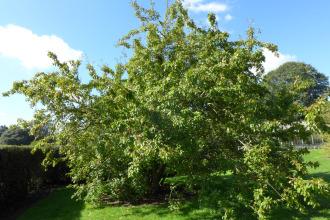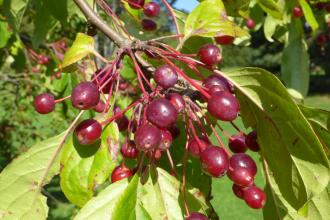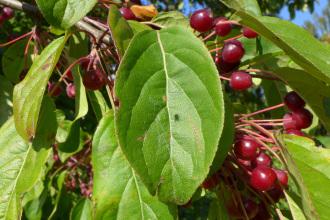
Malus halliana (19/09/2015, Kew Gardens, London)
Position: Full sun
Flowering period: Late spring
Soil: Moist, well drained
Eventual Height: 5m
Eventual Spread: 5m
Hardiness: 4a, 4b, 5a, 5b, 6a, 6b, 7a, 7b, 8a, 8b
Family: Rosaceae

Malus halliana Fruit (19/09/2015, Kew Gardens, London)
Malus halliana is a deciduous tree with a spreading habit. Its mid green leaves are often tinged purple adaxially, ovate to elliptic with serrulate margins, up to 8cm long and 4.5cm broad. Its gray or purple/ brown bark is shallowly fissured, forming peeling plates with age. Its pink flowers are held in corymbs up to 6cm across and appear at the same time as its leaves. Its red/ purple fruit is a pomme, up to 8mm across and matures in autumn.
Malus halliana, commonly known as the Hall Crab Apple or Adirondak Crabapple, is native to eastern Asia, including China and japan. Malus halliana is synonymous with Pyrus halliana and Malus domestica var. halliana.

Malus halliana Leaf (19/09/2015, Kew Gardens, London)
The etymological root of the binomial name Malus is from the ancient Latin name for the apple tree. Halliana is named after Dr. George Rogers Hall (1822-1899), an American doctor working in Shanghai.
The landscape architect may find Malus halliana useful as a small specimen tree with attractive spring flowers and edible fruit.

Malus halliana Bark (19/09/2015, Kew Gardens, London)
Ecologically, Malus halliana flowers are attractive to pollinating insects. Its fruit are attractive to birds and some mammals (including humans).
Malus halliana prefers moist, fertile, well-drained soils. It tolerates most pH of soil.
Malus halliana requires little maintenance. Dead or damaged material may be removed in winter.

Landscape Architecture

